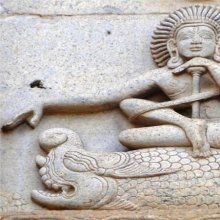Sailor: 1 definition
Introduction:
Sailor means something in the history of ancient India. If you want to know the exact meaning, history, etymology or English translation of this term then check out the descriptions on this page. Add your comment or reference to a book if you want to contribute to this summary article.
Images (photo gallery)
India history and geography
Source: Singhi Jain Series: Ratnaprabha-suri’s Kuvalayamala-katha (history)Sailors (of ships or boats) were subjected to certain preparatory rituals performed before Sea-voyages in ancient India (known in Prakrit as: jattā, or Sanskrit: yātrā), and was vividly depicted in the Kathās (narrative poems) such as Uddyotanasūri in his 8th-century Kuvalayamālā (a Prakrit Campū, similar to Kāvya poetry).—Details of preparation for sea-voyage are given which include the following items relating to preparatory ritual and the equipment of the ship: [e.g., bringing together other sailors;] [...]. When the ship was to take off auspicious musical instruments were sounded, conch-shells were blown, auspicious songs were sung, [...].

The history of India traces the identification of countries, villages, towns and other regions of India, as well as mythology, zoology, royal dynasties, rulers, tribes, local festivities and traditions and regional languages. Ancient India enjoyed religious freedom and encourages the path of Dharma, a concept common to Buddhism, Hinduism, and Jainism.
See also (Relevant definitions)
Full-text (+115): Navika, Niryama, Pratitara, Naujivika, Niyamaka, Naucara, Daryavardi, Shaphari, Samudrayayin, Navik, Karnadhara, Naukarman, Mallaha, Pota, Malaha, Potavaha, Sailor's tobacco, Blue sailors, Mallah, Naviki.
Relevant text
Search found 42 books and stories containing Sailor; (plurals include: Sailors). You can also click to the full overview containing English textual excerpts. Below are direct links for the most relevant articles:
The Sky Lamp < [October – December, 1985]
Lone Sailor < [October – December 1991]
Mother Teresa < [July – September, 1993]
Trishashti Shalaka Purusha Caritra (by Helen M. Johnson)
Part 1: Story of Sāgarada < [Chapter IV - The wandering and emancipation of Pārśvanātha]
Part 11: Sudāḍha’s enmity < [Chapter III - Mahāvīra’s first six years as an ascetic]
Part 8: Reincarnation of Dharaṇa (second of Malli’s six former friends) < [Chapter VI - Śrī Mallināthacaritra]
Popular Literature in Ancient Egypt (by Alfred Wiedemann)
Lord Jhulelal: An Analytical Study (by Thakkar Harish Gopalji)
Part 6.1 - Dariyalal in the Gujarati language < [Chapter 2 - Literature Review]
Part 23 - Bhatia People < [Chapter 2 - Literature Review]
Part 6.2 - Dariyalal by Gunvantrai Acharya in English, translated by Kamal Sanyal < [Chapter 2 - Literature Review]
Egypt Through The Stereoscope (by James Henry Breasted)
Position 33 - Dahabiyehs On The River Ready For The Journey To The Upper Nile < [Standpoints In Egypt]
Position 1 - Pompey's Pillar, The Sailors' Landmark, And Modern Alexandria, North Toward The Sea < [Standpoints In Egypt]
Rig Veda (translation and commentary) (by H. H. Wilson)
Rig Veda 8.96.11 < [Sukta 96]
